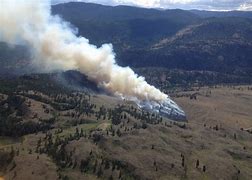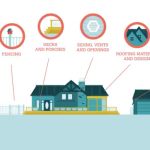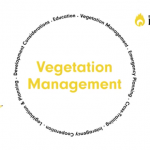FireSmart Basics
 As identified in the BC Flood and Wildfire Review, there is a critical need to “strengthen public understanding of the risks and personal responsibilities associated with living in a fire-dependent ecosystem.” The general goal of FireSmart is to encourage communities and citizens to adopt and conduct FireSmart practices to mitigate the negative impacts of wildfire to assets on public and private property. The FireSmart program is implemented through seven disciplines to help address the threat of wildfire: education, emergency planning, vegetation management, legislation, development, interagency cooperation and cross training.
As identified in the BC Flood and Wildfire Review, there is a critical need to “strengthen public understanding of the risks and personal responsibilities associated with living in a fire-dependent ecosystem.” The general goal of FireSmart is to encourage communities and citizens to adopt and conduct FireSmart practices to mitigate the negative impacts of wildfire to assets on public and private property. The FireSmart program is implemented through seven disciplines to help address the threat of wildfire: education, emergency planning, vegetation management, legislation, development, interagency cooperation and cross training.
Regional District of Okanagan-Similkameen
 The Community Resiliency Investment (CRI) FireSmart Community Funding & Supports program was announced by the provincial government in 2018 and provides funding to local governments to increase community resiliency by undertaking community-based FireSmart planning and activities that reduce the community’s risk from wildfire. The RDOS actively applies for funding that supports the seven FireSmart discipline activities towards increasing resiliency and reducing the RDOS’s risk from wildfire.
The Community Resiliency Investment (CRI) FireSmart Community Funding & Supports program was announced by the provincial government in 2018 and provides funding to local governments to increase community resiliency by undertaking community-based FireSmart planning and activities that reduce the community’s risk from wildfire. The RDOS actively applies for funding that supports the seven FireSmart discipline activities towards increasing resiliency and reducing the RDOS’s risk from wildfire.
FireSmart Guides
FireSmart Homeowner’s Manual
Whether you are doing regular yard maintenance or making large scale changes during renovations or landscaping, you can make choices that will help protect your home from wildfire. Download the manual.
FireSmart in Nine Easy Steps
You and your neighbours can reduce wildfire hazards by following simple, preventative steps.
FireSmart Guide to Landscaping
By making strategic choices in your yard, you can create a FireSmart landscape. This guide includes an extensive list of fire-resistant plants plus tips about FireSmart gardening.
FireSmart Evacuation Checklist
Download this last-minute checklist for protecting your home and property from wildfire.
Videos
Neighbourhoods
As the population continues to grow and neighbourhoods become more intertwined within the forested and grassland areas of the country, the risk of wildfire grows significantly. Many neighbourhoods face a high to extreme wildfire risk. The FireSmart program outlines proactive measures that neighbourhoods can take to reduce the risk.
Neighbourhood FireSmart Recognition Program
Find out how neighbourhoods, subdivisions, and small towns prone to wildfire can become a FireSmart Neighbourhood.
Learn more
Learn how to become a Recognized FireSmart Neighbourhood.
Learn more
Terminology
Community Wildfire Protection Plans (CWPPs) - local plans that are designed to specifically address a community’s unique conditions, values, and priorities related to wildfire risk reduction and resilience.
FireSmart - a brand owned by FireSmart Canada that includes a comprehensive set of tools and guidance on how to undertake and implement community-based wildfire prevention and mitigation initiatives.
FireSmart is based on the premise of shared responsibility and promoting integration and collaboration on wildfire prevention and mitigation. It is founded on seven disciplines that are under the responsibility or mandate of different organizations and/or levels of government.
Fuel management - the modification of forest structure to reduce forest fuel accumulations available to burn in a wildfire. The main goal of fuel management is improving public safety. This may include treatments such as thinning, spacing and pruning trees, and removal of needles and woody debris from the forest floor.
Interface fires - fires that have the potential to involve buildings and forest fuel or vegetation simultaneously.
Mitigation - actions taken to reduce the impact of disasters in order to protect lives, property, the environment, and to reduce economic disruption.
Prescribed fire - the knowledgeable and controlled application of fire to a specific area to accomplish planned resource management objectives. These fires are managed in such a way as to minimize the emission of smoke and maximize the benefits to the site.
Prevention – actions taken to avoid the occurrence of negative consequences associated with a given threat; prevention activities may be included as part of mitigation.
Wildfire - an unplanned fire - including unauthorized human-caused fires - occurring on forest or range lands, burning forest vegetation, grass, brush, scrub, peat lands, or a prescribed fire set under regulation which spreads beyond the area authorized for burning.
Wildland urban interface - as defined in the FireSmart manual, the wildland urban interface (WUI) is any area where combustible forest fuel is found adjacent to homes, farm structures or other outbuildings. This may occur at the interface, where development and forest fuel (vegetation) meet at a well-defined boundary, or in the intermix, where development and forest fuel intermingle with no clearly defined boundary.





